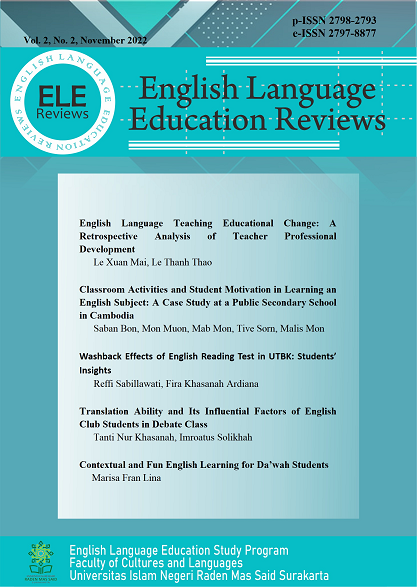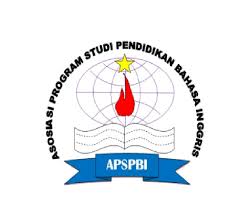Washback Effects of English Reading Test in UTBK: Students’ Insights
DOI:
https://doi.org/10.22515/elereviews.v2i2.5333Keywords:
washback effect, English language teaching, language assessment, high-stakes test, state university entrance examinationAbstract
Ujian Tulis Berbasis Komputer (UTBK) is a high-stakes test for students. They strive to pass the test and be accepted in their targeted institution. As one of the subjects involved in UTBK, the English test surely has influenced English teaching & learning in 12th-grade classrooms. This impact is known as the washback effect. While most studies investigate the washback effect on a test as a whole subject, little is known about the effect on the particular part of the test. Thus, this case study explores the washback effect of the English reading test in UTBK on the students’ perceptions, learning motivation, learning strategies, and learning content. The data were collected through online questionnaires distributed to six participants from different senior high schools. The deductive analysis found that the test has positive and negative effects seen from the students’ insights. UTBK can avoid cheating and integrate students’ English competence, but they are uncertain that it can improve their communicative competence. This study might enrich educational studies in English language teaching in general and language assessment in particular.
Downloads
References
Alderson, J.C., & Wall, D., (1993). Does washback exist? Appl. Linguist, 14, 115-129.
Alfari, S. (2021). Sistem penilaian IRT di UTBK SBMPTN dan strategi mengerjakannya. https://www.ruangguru.com/blog/sistem-penilaian-irt-di-utbk-sbmptn-dan-strategi-mengerjakannya
Ali, Md. M., & Hamid, M. O. (2020). Teaching English to the test: Why does negative washback exist within secondary education in Bangladesh? Language Assessment Quarterly, 17(2), 129-146. https://doi.org/10.1080/15434303.2020.1717495
Bachman, L. F., & Palmer, A. S. (2010). Language assessment in practice: Developing language assessments and justifying their use in the real world. Oxford University Press.
Bailey. K.M. (1996). Working on washback: a review of the washback concept in language testing. Language Testing. 13(3), 257-279.
Bailey, J.L. (2018). A study of the washback effects of university entrance examinations on teaching pedagogy & student learning behaviour in Japanese high schools. British Journal of Education. 6(6), 50-72.
Carlson, J.E. (2021). Introduction to item response theory models and applications. Routledge.
Cheng, L. (1997). How does washback influence teaching? Implications for Hong Kong. Language and Education. 11(1), 38-54.
Cheng, L. & Curtis, A. (2004). Washback or backwash: A review of the impact of testing on teaching and learning. In Cheng, L., Watanabe, Y., & Curtis, A. (Eds). Washback in Language Testing: Research Contexts & Methods. Lawrence Erlbaum Associates.
Damankesh, M., & Babaii, E. (2015). The washback effect of Iranian high school final examinations on students’ test-taking and test-preparation strategies. Studies in Educational Evaluation, 45, 62-69. https://doi.org/10.1016/j.stueduc.2015.03.009
de Ayala, R.J. (2013). The IRT tradition and its applications. In T.D. Little (Ed.), The Oxford Handbook of Quantitative Methods. Oxford University Press.
Dong, M. Fang, J. & Xu, J. (2021). Differential washback effects of a high-stakes test on students’ English learning process: Evidence from a large-scale stratified survey in China. Asia Pacific Journal of Education. https://doi.org/10.1080/02188791.2021.1918057
Dorobat, D. (2007). The methodology of evaluation and testing. Ministerul Educatiei si Cercetarii. Proiectul Pentru Invatamantul Rural.
Hughes, A. (2003). Testing for language teachers (2nd ed.). Cambridge University Press.
Jianrattanapong, A. (2011). Positive washback from Thai university entrance examinations. Language Testing in Asia. 1(1).
Khanshan, S.K. (2018). An examination of the washback effect on Iranian EFL learners’ reading comprehension: Any implications for text difficulty in the classroom? International Journal of Language Testing and Assessment, 1(2), 9-16.
Kim, S.H., Cohen, A.S., & Eom, H.J. (2021). A note on the three methods of item analysis. Behaviourmetica, 48, 345-367. https://doi.org/10.1007/s41237-021-00131-1
Kuang, Q. (2020). A review of the washback of English language test on classroom teaching. English Language Teaching. 13(9).
Pizzaro, M.A. (2009). Does the English teaching in the Spanish university entrance examination influence the teaching of English? English Studies. 90(5), 582-598.
Ramezaney, M. (2014). The washback effects of the university entrance exam on Iranian EFL teachers’ curricular planning and instruction techniques. International Conference on Current Trends in ELT. Elsevier Ltd.
Republika. (2022). Persiapan UTBK 2022, berikut materi tes TPS bahasa Inggris yang harus kamu pelajari. Republika. https://kampus.republika.co.id/posts/36636/persiapan-utbk-2022-berikut-materi-tes-tps-bahasa-inggris-yang-harus-kamu-pelajari
Safitri, I.D. (2018). The washback effect of CAT on students’ learning in EFL classroom. ELS Journal on Interdisciplinary Studies in Humanities, 1(3), 252-262.
Sadeghi, K., Ballidag, A., & Mede, E. (2021). The washback effect of TOEFL iBT and a local English proficiency exam on students’ motivation, autonomy and language learning strategies. Heliyon, 7. https://doi.org/10.1016/j.heliyon.2021.e08135
Salehi, H. & Yunus, M., M.D. (2012). The washback effect of the Iranian universities entrance exam: Teachers’ insights. Journal of Language Studies. 12(2).
Santos, J.S., Andrade, W.L., Brunet, J. & Melo, M.R.A. (2020). A systematic literature review of methodology of learning evaluation based on item response theory in the context of programming teaching. 2020 IEEE Frontiers in Education Conferences, Upsala, Sweden. https://doi.org/10.1109/FIE44824.2020.9274068
Smith, T.I., Louis, K.J., Ricci, B.J. & Bendjilali, N. (2020). Quantitatively ranking incorrect responses to multiple-choice questions using item response theory. Physical Review Physics Education Research, 16, 10107. https://doi.org/10.1103/PhysRevPhysEducRes.16.010107
Thanh, M.N.H. (2020). Beyond the washback of the English national exam on learning: Subsequent impact on language learning strategies of first-year English majors. Language Education & Assessment. 3(2), 38-57. https://doi.org/10.29140/lea.v3n2.356
Wall, D. & Alderson, J.C. (1992). Examining washback: The Sri Lankan impact study. Language Testing. 10(1), 41-69.
Wang, C., Yan, J. & Liu, B. (2014). An empirical study on washback effects of the Internet-Based College English Test Band 4 in China. English Language Teaching. 7(6).
Watanabe, Y. (1996). Does grammar translation come from the entrance examination? Preliminary findings from classroom-based research. Language Testing. 13(3), 318-333.
Yildirim, O. (2010). Washback effects of a high-stakes university entrance exam: Effects of the English section of the university entrance exam on future English language teachers in Turkey. The Asian EFL Journal Quarterly. 12(2).
Zubaidah, N. (2021). Menuju SBMPTN 2022, ini 3 materi UTBK yang akan diujikan. Sindonews. https://edukasi.sindonews.com/read/626697/211/menuju-sbmptn-2022-ini-3-materi-utbk-yang-akan-diujikan-1639372320#:~:text=Sebab%20nilai%20Bahasa%20Inggris%20itu%20diperlukan%20untuk%20mendukung,dalam%2028%20sesi%20atau%202%20sesi%20setiap%20harinya.
Downloads
Published
How to Cite
Issue
Section
Citation Check
License
Copyright (c) 2022 Reffi Sabillawati, Fira Khasanah Ardiana

This work is licensed under a Creative Commons Attribution-NonCommercial 4.0 International License.
Authors retain copyright and grant the journal right of first publication with the work simultaneously licensed under a Creative Commons Attribution License that allows others to share the work with an acknowledgement of the work's authorship and initial publication in this journal.
This ejournal system and its contents are licensed under
a Creative Commons Attribution-NonCommercial 4.0 International License








